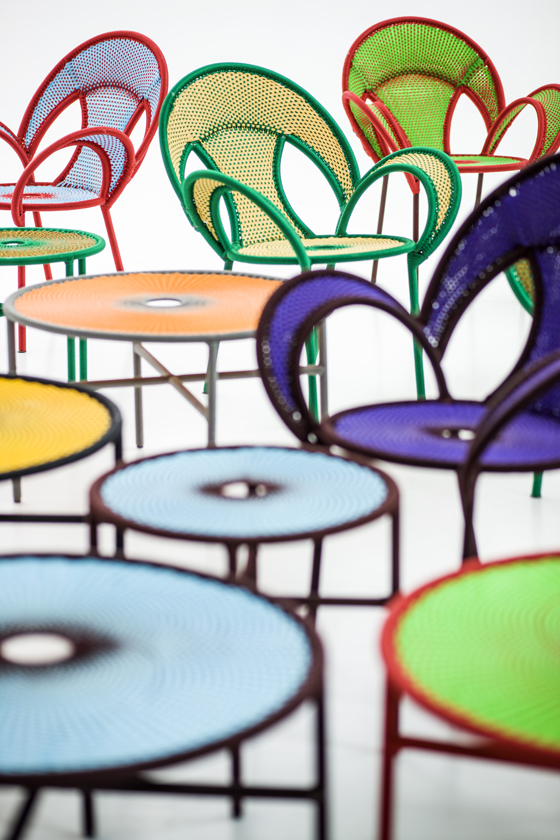African Design Now
Texto por Nana Ocran
06.08.18
Esta página ha sido archivada y ya no se actualiza
Africa’s influence on contemporary design continues to expand.
Tord Boontje, Shadowy Collection, ed. Moroso, exposition M'Afrique exhibition
When Cape-Town based creative platform Design Indaba asked Li Edelkoort to curate an exhibition of African design, the global forecaster already had a strong vision. Her idea was to fuse the work of South African artists with the aesthetics from a popular, 1980s design movement.
This was back in 2013 when Edelkoort – renowned for her insights into the evolution of socio-cultural trends – had previously noted the ‘kinship’ between Milan’s Memphis design movement and Africa’s traditional craft motifs. The cultural clash of zebra prints, disco colours and totemic structures of what had previously come out of Milan had an obvious African influence, so what emerged from Edelkoort’s thinking was Totemism: Memphis meets Africa - a showcase that ultimately created an updated moment of playful Afro-Italian thinking.
Totemism - Memphis Meets Africa, at Design Indaba Photo: © Riccardo Pugliese
Hassan Hajja & Reebok sneaker, collaboration with Senegalese mat influences
Photographer and filmmaker Hassan Hajjaj Photo: © Camille Zakharia
Undoubtedly a provocative and celebratory cultural fusion, but definitely not a new one. Totemism had been preceded four years earlier by M’Afrique, both an exhibition and a collection series developed by artisan furniture makers, Moroso. With a more commercially-leaning desire to “go beyond the stereotypes,” creative director Patrizia Moroso worked with designer Stephen Burks, who produced an installation of furniture and objects created by a range of African and non African designers to robustly promote the fact that Africa was more than a “tragic” continent or “at best, an erotic experience.”
Beautiful pieces crafted from the woven nets of Senegalese fisherman showed that extreme beauty exists wherever it’s looked for; inevitably, the potency of fusing African ideas with western sensibilities. A major design collaborator, Burks has long had his own take on what he sees as the two-way impact of partnerships that involve African and non-African partners, as well as the “untraceable answers” he refers to in reference to his exact heritage as an African American – although he’s “constantly reminded that they exist.”
A continent of 54 countries and countless tribes and cultures, Burks feels that Africa has become “a symbol of all causes that want to be socially conscious, sustainable and ‘developing’.”
Top: Stephen Burks Photo: © Emin; Above and middle: Stephen Burks ManMade lamps for Dedon's 'The Others' collection with 'cute' rounded eyes

Top: Stephen Burks Photo: © Emin; Above and middle: Stephen Burks ManMade lamps for Dedon's 'The Others' collection with 'cute' rounded eyes
×It’s an honest and interesting viewpoint. With clients that have included Italian manufacturer, Capellini, fashion house Missoni and French furniture retailer Roche Bobois, Burks is aware that future facing brands like these, in their awareness of Africa’s status as an emerging continent, have touched on African influences in their collections.
The type of impact he’s added to mixed cultured projects is perhaps best exemplified in his work with furniture makers, Dedon. Burk’s series of anthropomorphic solar– powered lanterns, The Others, made an aesthetically tactile as well as political design statement, each designed with ‘cute’ rounded eyes as a form of visual messaging. Borne from a “frustration with the arrogance of people outside of the developing world towards people in it,” the narrative of rising nationalism and the resistance to immigration are what influenced the design whereby the objects seem to “stare back” in a way that reminds us of our own ability to be judged, looked at or marginalised.
'Ostrich in Love' outdoor chairs, inspired by the courtship dance of ostrich birds living in East Africa, coll. M'Afrique Collection, ed. Moroso, designs: Patricia Urquiola, Tord Boontje Photo: © Moroso

'Ostrich in Love' outdoor chairs, inspired by the courtship dance of ostrich birds living in East Africa, coll. M'Afrique Collection, ed. Moroso, designs: Patricia Urquiola, Tord Boontje Photo: © Moroso
×Yinka Ilori with upcycled chair featuring his MiAdidas colour scheme for a WeTransfer collaboration

Yinka Ilori with upcycled chair featuring his MiAdidas colour scheme for a WeTransfer collaboration
×Spooling backwards in time, a post-millennium African energy of youth-led creative dynamism has been shape-shifting the design world for quite a while now. African or diasporic names that have come to the surface have been picked up across the creative spectrum. Impacts from small cities, towns and suburbs throughout Africa have reached the lips of global enterprises, and even problematic places such as Kenya’s Kibera slum have been the source of innovative ideas about recycled material. It’s the area where artist Cyrus Kabiru first pieced together his C-Stunner glasses, now celebrated across platforms for creating style based on what might be for some, materials of necessity.
It’s evident that the continent’s western impacts (although not new) are expanding, with global brands stepping up to forge unique design partnerships. Established names in this mix include Hassan Hajjaj – The Warhol of Morocco – who last year, brought north African and Senegalese influences to a Reebok US sneaker collection, while London-Nigerian Yinka Ilori worked with WeTransfer and MiAdidas to produce colourway ideas for customized trainers. As a unique furniture designer, Ilori’s Yoruba-influenced designs have also found their way to Stockholm’s Ethnographic Museum, where his vivid designs will launch the venue’s opening in April this year.
The dynamic and future-facing “mix and match” impacts of African (and diasporic African) design thinking are destined to reshape the global design world, particularly as the obvious 21st centuriness of Africa is brought into more global narratives. From catwalks to movie screens, a palpable and continuous focus on Africana shows that the continent is more that just “hot.” In fact, if life as we know it really does imitate art, then in a world in which Marvel can dexterously push the silver screen Wakanda fantasy, perhaps Africa’s impact on western design will not only continue be future facing, but potentially Afrofuturistc as well.
Text by: Nana Ocran














